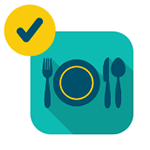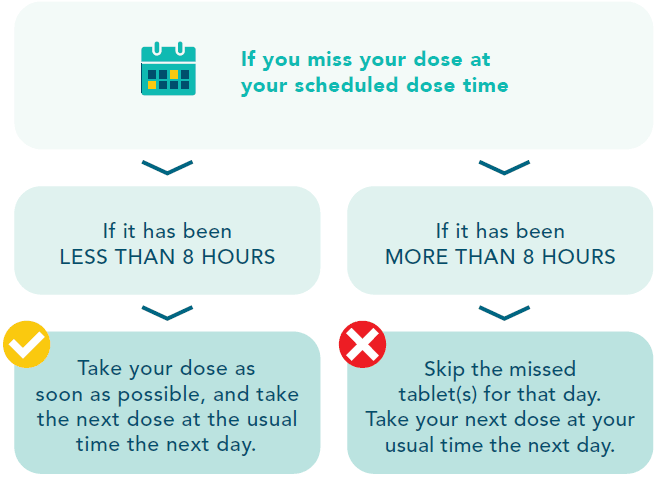Taking VENCLEXTA
YOUR TREATMENT JOURNEY WITH VENCLEXTA
Before VENCLEXTA treatment begins:
- It’s important you stay well hydrated when taking VENCLEXTA.
- Make sure you drink plenty of water (6 to 8 glasses or 1.5 to 2 L per day) as instructed, throughout your treatment with VENCLEXTA, especially at the start of your treatment and every time your dose is increased during the gradual dose-increase phase.
- If you are in hospital, you might receive hydration through a drip.
- If your doctor has requested that you take other medications prior to VENCLEXTA, follow your doctor’s instructions on how to take them.
Importance of blood tests
VENCLEXTA breaks down the cancer cells in your body. As a result, there can be some changes to your blood chemistry that are important to monitor. Your healthcare team will arrange blood tests for you before you start VENCLEXTA and during the initial stages of treatment. It is important you keep to all your scheduled appointments.
What happens during treatment?
Depending on what your doctor advises, your treatment with VENCLEXTA will be either entirely as an outpatient (at home or in the day-stay unit at the hospital), or start as an inpatient in hospital with a transition to treatment at home. For your first few days of treatment your healthcare team will closely monitor how your treatment is working. One of the ways they do this is by taking blood tests.
It’s important to keep an eye on how you’re feeling so you can let your healthcare team know if you’re experiencing any side effects.
For further details see Safety Information.
THINGS YOU SHOULD KNOW
BEFORE TAKING VENCLEXTA
Other medicines and VENCLEXTA
Tell your doctor or pharmacist if you take any of the following medicines as they can increase or decrease the effect of VENCLEXTA in your body:*
- Medicines for fungal infections – ketoconazole, posaconazole, voriconazole, itraconazole, or fluconazole
- Antibiotics to treat bacterial infections – clarithromycin, ciprofloxacin, erythromycin, azithromycin, or nafcillin
- Medicines for HIV and/or hepatitis C infections – efavirenz, etravirine; or ritonavir
- Medicines to treat raised blood pressure, angina or other heart conditions – diltiazem, verapamil, captopril, felodipine, dronedarone, amiodarone, quinidine, carvedilol, or ranolazine
- Medicine used to treat tuberculosis and other serious infections – rifampicin
- Medicine used to suppress the immune system – ciclosporin
- Herbal products – quercetin, or St. John’s wort
- Medicine used to help stop clots forming to reduce the chance of a heart attack/stroke – ticagrelor
- Medicines to prevent seizures or to treat epilepsy – carbamazepine, or phenytoin
- Medicine used to treat high blood pressure in the lungs – bosentan
- Medicine to treat certain sleep disorders – modafinil
*For a full list please see the Consumer Medicines Information.
Your doctor may change your dose of VENCLEXTA if you are taking any of the above medicines or herbal products.
Tell your doctor if you take any of the following medicines as VENCLEXTA may affect how they work:
- Medicine used to thin the blood – warfarin
- Medicine used to treat certain heart conditions – digoxin
- Medicine used to treat certain cancers – everolimus
- Medicine used to help in organ transplants – sirolimus
Tell your doctor or pharmacist if you are taking, have recently taken or might take any other medicines.
- medicines without a prescription
- vitamins
- supplements
- herbal medicines
Talk to your healthcare team before taking VENCLEXTA if you:
- Have any problems with your liver or kidneys
- Think you may have an infection
- Have had any recent vaccinations
- Take any medicines for any other condition
Do not take VENCLEXTA if you are allergic to VENCLEXTA or any other ingredients in the product. Talk to your doctor or pharmacist if you are unsure.
Tumor Lysis Syndrome (TLS):
TLS is caused by the rapid breakdown of cancer cells resulting in high levels of certain chemicals and low levels of calcium circulating in the blood. This situation can cause serious damage to the kidneys as well as other organs in the body.
The risk for TLS is usually the highest in the first days of treatment with VENCLEXTA, as you increase your dose.
To help prevent TLS, it is important to stay hydrated and drink water every day when taking VENCLEXTA.
Keep all your appointments, including those for your blood tests, since the changes in your blood that can lead to TLS may not have any symptoms until the situation becomes very serious. Take any additional medicines your doctor may prescribe to help prevent TLS.
It is recommended that you drink 6 to 8 glasses (approximately 1.5 to 2 litres total) of water each day, starting two days before and on the day of your first dose of VENCLEXTA, and every time the dose is increased.
TAKING VENCLEXTA
Starting Treatment
- Your healthcare team will start you on a low dose of VENCLEXTA and increase it each day until you reach your recommended dose
(also called the dose increase or dose titration phase). - You will have blood tests before and after each dose during the dose increase phase to monitor how your body is reacting.
- Your recommended dose depends on a number of things, including whether you are taking any other medicines, have any other health conditions and how you react to the treatment.
- Once you have reached your recommended dose, and your healthcare team is happy for you to do so, you will be able to continue VENCLEXTA treatment at home.
You should take VENCLEXTA as advised by your healthcare team at the prescribed dose. Do not change your dose or stop taking VENCLEXTA unless your healthcare team tells you to do so.
Two days before you start taking VENCLEXTA, drink at least 6 to 8 glasses of water each day and continue to do this throughout your treatment, especially each time your dose is increased.




This includes:
- Eating them (including jams or marmalades)
- Drinking their juice
- Taking supplements that might contain them
They can increase the effect of VENCLEXTA in your body.
Staying Hydrated
It is important to stay hydrated when taking VENCLEXTA and drink about 6 to 8 glasses (1.5 to 2 litres) of water each day as instructed.
Make especially sure you drink your 6-8 glasses of water on these days:
- The two days before, and the day that you take your first VENCLEXTA dose
- The two days before, and the day you increase your VENCLEXTA dose.

VENCLEXTA oral dosing schedule






For illustrative purposes only, pills are not actual size.
*Intravenous (IV) means within a vein. In this type of injection, the medication is injected directly into the vein.
#Subcutaneous (SC) means under the skin. In this type of injection, the medication is injected into the tissue layer between the skin and the muscle.
Your doctor may delay, decrease, or stop treatment for a period of time based on your lab work. This is common in treatment management. Be sure to ask your doctor if you have any questions about changes in dosing.
If you miss a dose of VENCLEXTA
It is important not to miss a dose of this medicine.

If you vomit after taking VENCLEXTA
If you vomit after taking VENCLEXTA, do not take an extra dose. Take the correct dose at your usual time the next day. If you are unsure, talk to your doctor, nurse or pharmacist.
If you take too much VENCLEXTA
If you think you (or anyone else) may have taken too much VENCLEXTA,
- Contact the National Poisons Centre on 0800 764 766, and
- Contact your doctor or
- Go to Accident and Emergency at your nearest hospital.
Do this even if there are no signs of discomfort or poisoning.
QUESTIONS TO ASK YOUR DOCTOR ABOUT VENCLEXTA
You may have many questions for your doctor about VENCLEXTA and sometimes it can be hard to remember everything. Writing down the questions in advance can help.
Here are some questions to get you started.
- What is the medicine?
- Can I take it from home or in a clinic?
- Are there any special dietary requirements when taking the medicine?
- How long will I need to take it for?
- How will it make me feel?
- What can you tell me about any side effects with this medicine?
- How will we know if it is working?
- What can I do to reduce or manage side effects?
- When should I start taking the medicine?
- What other options are available to me?
- Who will I contact if I have any questions?
NZ-VENA-240002. TAPS BG4140. July 2024.
For more information about AbbVie, the maker of VENCLEXTA, visit www.abbvie.co.nz
For medical information enquiries regarding VENCLEXTA please contact [email protected]
The content on this site is intended solely for New Zealand residents. The information is intended for informational purposes only and should not be used to replace a discussion with a healthcare professional. All decisions made regarding patient care must be handled by a healthcare professional and be made based on the unique needs of each patient. This website has been developed and is funded by AbbVie Limited, Wellington. The person shown is from stock photography (model) and is not an actual patient.
VENCLEXTA in combination with rituximab is fully funded for relapsed/refractory chronic lymphocytic leukaemia (CLL). Special Authority criteria apply. Refer to the VENCLEXTA PHARMAC Special authority criteria. VENCLEXTA in combination with obinutuzumab or ibrutinib for 1L CLL is not funded - a charge will apply. VENCLEXTA is not funded for acute myeloid leukaemia (AML) - a charge will apply.
IMPORTANT INFORMATION ABOUT VENCLEXTA®
VENCLEXTA® is a prescription medicine containing venetoclax. Venclexta is available as film-coated tablets of various strength (10 mg, 50 mg, 100 mg venetoclax). It is used to treat adults with chronic lymphocytic leukaemia (CLL) or small lymphocytic lymphoma (SLL) or acute myeloid leukemia (AML). Venclexta is taken alone or in combination with other medicines. Your doctor will let you know which combination medicines, how to take them, and how long to take them. Typically, you will start treatment with Venclexta at a low dose. If you are taking Venclexta for CLL or SLL, your doctor will gradually increase your dose over 5 weeks up to the full dose. If you are taking Venclexta for AML, your doctor will gradually increase your dose up to the full dose over 3, or 4 days, depending on the combination medicine used. Use strictly as directed by your doctor. Venclexta has risks and benefits. You must not take it if you are allergic to venetoclax or to any of the inactive ingredients. For CLL or SLL, do not take Venclexta if you are taking any of the following medicines: medicines used to treat or prevent fungal infections, including ketoconazole, posaconazole, voriconazole, itraconazole; clarithromycin (an antibiotic); or ritonavir (a medicine used to treat HIV and hepatitis C). Do not drink grapefruit juice, or eat grapefruit, starfruit or Seville oranges or marmalades. Do not give Venclexta to children and adolescents under 18 years of age. Do not take Venclexta if you are pregnant or plan to become pregnant, or if you are breastfeeding or plan to breastfeed. If you are a woman of child-bearing age, you must use a highly effective form of contraception during treatment with Venclexta and for at least 30 days after your last dose. Tell your doctor, nurse, or pharmacist if you have any kidney or liver problems; if you think you may have an infection; or if you recently received or are scheduled for any vaccinations. Do not stop using Venclexta or change the dose without checking with your doctor. Venclexta can cause tumour lysis syndrome (TLS) , which is caused by the fast breakdown of cancer cells. TLS is a very serious side effect that can be fatal. TLS is most likely to occur when you are first starting treatment. To help prevent TLS, it is important to stay hydrated and drink water every day when taking Venclexta. Particularly, starting two days before and on the day of your first dose of Venclexta and every time the dose is increased, drink 6 to 8 glasses (approximately 1.5-2 L total) of water each day. Let your healthcare provider know immediately if you experience: fever or chills; feeling sick or vomiting; being short of breath; feeling unusually tired; changes in your heart rate (slow, fast or irregular); your urine looks dark or cloudy; feeling confused; convulsions or fits; or pain in the muscles or joints while on treatment with Venclexta. Ensure you follow all your doctor’s instructions carefully and keep all your appointments, including those for blood tests. You may experience a low number of neutrophils, a type of white blood cells – this can be severe and need treatment. Your doctor will check your blood counts during treatment with Venclexta. You may experience infections during treatment with Venclexta. Some infections can be very serious or even fatal. Your doctor will closely monitor and treat you right away if you have fever or any signs of infection during treatment with Venclexta. Tell your doctor immediately if you have signs of an infection before, or while taking Venclexta, including: fever or chills, feeling weak or confused, cough, runny nose, sore throat; congestion on the chest; or pain or burning when passing urine. Some of the less serious side effects of Venclexta include diarrhoea; tummy pain; constipation, nausea (feeling sick); vomiting; reduced appetite; weight loss; mouth sores; looking pale; feeling tired; having little or no energy; shortness of breath when exercising; feeling dizzy; headache; low blood pressure; bleeding. Tell your doctor or pharmacist if you notice anything else that is making you feel unwell. Some medicines and Venclexta may interfere with each other, so tell your doctor if you are taking medicines containing any of the following: ketoconazole, posaconazole, voriconazole, itraconazole, fluconazole, clarithromycin, ciprofloxacin, erythromycin, ritonavir, diltiazem, verapamil, captopril, felodipine, dronedarone, amiodarone, quinidine, rifampicin, carvedilol, ciclosporin, quercetin, ranolazine, ticagrelor, azithromycin, nafcillin, carbamazepine, phenytoin, St John’s wort (Hypericum perforatum), bosentan, efavirenz, etravirine, modafinil, warfarin, digoxin, everolimus, or sirolimus. Tell your doctor or pharmacist if you are taking any other medicines, including any medicines, vitamins or supplements that you buy without prescription. Tell any other doctors, pharmacists, dentists, or surgeons treating you that you are taking Venclexta and remind them before you start any new medicines. If you have any questions about using Venclexta, including its risks and benefits, how much to use, how and when to use it, or storage conditions, ask your healthcare professional and refer to the Consumer Medicine Information (CMI) available from www.medsafe.govt.nz or free phone 0800 900 030. Ask your doctor if Venclexta is right for you. Use strictly as directed. If symptoms continue, or you have side effects, see your doctor, pharmacist, or healthcare professional. V7a.
©2024 AbbVie. All rights reserved. AbbVie® is a registered trademark of AbbVie Inc. VENCLEXTA® and its designs are registered trademark of AbbVie Manufacturing Management Unlimited Company. AbbVie Limited, PO Box 11437, Manners Street, Wellington 6142. TAPS BG4140. NZ-VEN-200006. ONO0142. October 2024.

